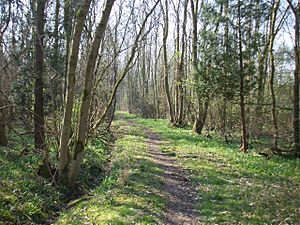Potton Wood facts for kids
| Site of Special Scientific Interest | |

A footpath through Potton Wood, showing young coppiced trees with bare branches
|
|
| Area of Search | Bedfordshire |
|---|---|
| Interest | Biological |
| Area | 85.5 hectares |
| Notification | 1984 |
| Location map | Magic Map |
Potton Wood is a special forest located about two miles east of the town of Potton in Bedfordshire, England. It's a big area, covering about 85 hectares (that's like 211 football fields!). This amazing woodland is part of Ampthill Forest and is looked after by Forest Enterprise, which is part of the Forestry Commission. They work hard to keep it healthy and beautiful for everyone to enjoy.
Contents
What Makes Potton Wood Special?
Potton Wood is so important that it has been named a Site of Special Scientific Interest (SSSI). This means it's a protected area because of its amazing nature. It's known for being an ancient woodland, which means parts of it have been continuously wooded for hundreds of years, possibly even since the year 1600!
The wood is mostly filled with oak, ash, and field maple trees. The way the trees and plants grow here is very typical of woodlands found on a special type of clay soil in West Cambridgeshire.
Amazing Plants and Trees
Potton Wood is home to many rare and interesting plants. You might spot the beautiful oxlip, which is a very rare flower in the UK and is at the edge of its natural range here in Europe. Other special plants include herb paris, the lovely bird's nest orchid, and the nettle-leaved bellflower.
You'll also find plants that are common in ancient woodlands, like the bright blue common bluebell, dog's mercury, yellow archangel, wood millet, and the delicate wood anemone.
For many years, some areas of Potton Wood had non-native conifer trees that were planted for commercial reasons. However, in 2004, these were removed. This was part of a big plan to help the ancient woodland grow back naturally, especially by bringing back a traditional way of managing trees called coppicing. Coppicing is a method where trees are cut down to ground level to encourage new shoots to grow, which helps the forest stay healthy and provides wood.
Animals You Might See
Potton Wood is buzzing with wildlife! If you're lucky, you might spot some mammals like fallow deer, grey squirrels, red foxes, European hares, and even European moles digging their tunnels.
The wood is also a great place for birdwatching. Keep an ear out for the beautiful songs of the common nightingale, common chiffchaff, blackcap, and common whitethroat. You might also see the gentle European turtle dove.
And don't forget the butterflies! Two stunning types you could spot fluttering around are the white admiral and the purple hairstreak.
A Bit of History
Potton Wood has a bit of history connected to World War II. On September 18, 1945, a B-24 Liberator bomber plane crashed on the southern edge of the wood. This plane was based at Bassingbourn in Cambridgeshire. Sadly, four men lost their lives in the accident. You can still see the spot where the plane fell today.
Visiting Potton Wood
If you want to explore Potton Wood, you can access it by footpaths from Hatley Road. It's a wonderful place to walk, enjoy nature, and learn about the amazing plants and animals that call it home.

